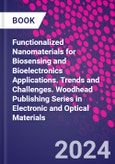Table of Contents
Part 1 Development of fabrication strategies of FNMS based biosensing and bioelectronics1. Biosensing: A promising approach for bioanalysis
2. Biosensing mechanisms and applications
3. Advantages of functionalized nanomaterials for sensor technology
4. Nanomaterial functionalization approaches for biosensing and bioelectronic applications
5. Molecularly imprinted polymer-based sensors: A way-forward concept for artificial antibodies
6. Biosensor development using functionalized 2D nanomaterials
7. Recent advancements in fabrication strategies for functionalized nanomaterial-based biosensors
8. Exploring the COVID-19 journey and cutting-edge biosensing approaches
Part 2 Application and future directions of different FNM-based biosensing and bioelectronics
9. Teaming up biosensor technology with agriculture: a detection approach for reframing agricultural sustainability and food security
10. Developments and challenges in diagnosing coronavirus: A biosensor point of view
11. Magnetic graphene nanocomposites for electrochemical detection of heavy metal ions in coal mine areas
12. Cancer diagnosis via functionalized nanomaterial-based biosensors
13. Biosensors and bioelectronics for advanced healthcare systems
14. Biosensors: A promising approach for healthcare applications
15. Challenges and prospects of functionalized nanomaterial-based biosensors
Authors
Sudheesh K. Shukla Department of Chemical Sciences, University of Johannesburg, Doornfontein Campus, Johannesburg, South Africa; Department of Biomedical Engineering, School of Biological Engineering and Life Science, Shobhit Institute of Engineering & Technology (Deemed-to-be University), Modipuram, Meerut, India; School of Chemical Engineering and Physical Sciences, Lovely Professional University, Phagwara, India.Sudheesh K. Shukla is a researcher with the Department of Chemical Sciences, University of Johannesburg, Doornfontein Campus, Johannesburg, South Africa; and Associate Professor at the School of Chemical Engineering and Physical Sciences, Lovely Professional University, Phagwara, India. His research involves real-time analysis of biochemical markers for personalized healthcare and environmental monitoring.
Chaudhery Mustansar Hussain New Jersey Institute of Technology, Newark, NJ, USA. Chaudhery Mustansar Hussain is an adjunct professor and director of laboratories in the Department of Chemistry and Environmental Sciences at the New Jersey Institute of Technology (NJIT), Newark, New Jersey, United States. His research is focused on the applications of nanotechnology and advanced materials, environmental management, analytical chemistry, and other various industries. Jagriti Narang Department of Biotechnology, School of Chemical and Life Science, Jamia Hamdard University, New Delhi, India.Jagriti Narang is an Assistant Professor at the Department of Biotechnology, Jamia Hamdard, New Delhi, and has work experience of more than 10 years. She has authored or coauthored many research papers in international peer-reviewed journals. She has edited four books and written several chapters. She is a committee member of many international conferences and is a member of Material Research Society of India and Society of Biological Chemistry. She is also an editor and peer reviewer of many international journals and has presented her papers on several international platforms. Dr. Narang has done extensive work on the fabrication of various biosensors for the diagnostic applications. She has proposed some laboratory models that can be converted into commercial monitoring device.
Roberto Pilloton Institute of Crystallography, National Research Council (CNR-IC), Rome, Italy.Since 1986, Roberto Pilloton has been at the forefront of advancing bioanalytical methods through the innovative use of electrochemical biosensors, particularly in the domains of food, clinical, and environmental analysis. His distinguished career includes roles as a senior researcher at two of Italy's leading research institutes: the ENEA "Italian Institute of Sustainable Development" and the CNR "National Research Council." In addition to his impactful research contributions, Pilloton has imparted his knowledge as an adjunct professor, specializing in Environmental Bioanalytical Chemistry, across several esteemed Italian universities and research institutes. His dedication to education is further demonstrated by his role as a mentor, guiding students in the development of master's and PhD theses, as well as mentoring national and international fellows. Pilloton's global influence extends beyond academic circles, as he has served as a visiting scientist in prominent institutions in Paris, Stuttgart, Nice, Braunschweig, Lund, Izmir, Ceske Budejovice, and Karaikudi. Moreover, he has played a pivotal role in shaping the landscape of international conferences on biosensors, having chaired or been a member of the scientific committee. From 2015 to 2018, Pilloton served as the elected vice president of the "International Association on Environmental Analytical Chemistry" (IAEAC). Currently, he holds the esteemed position of Editor-in-Chief of the International Journal of Environmental Analytical Chemistry at Taylor and Francis, and he is a valuable member of the editorial boards of two MDPI journals: Sensors and Biosensors.








